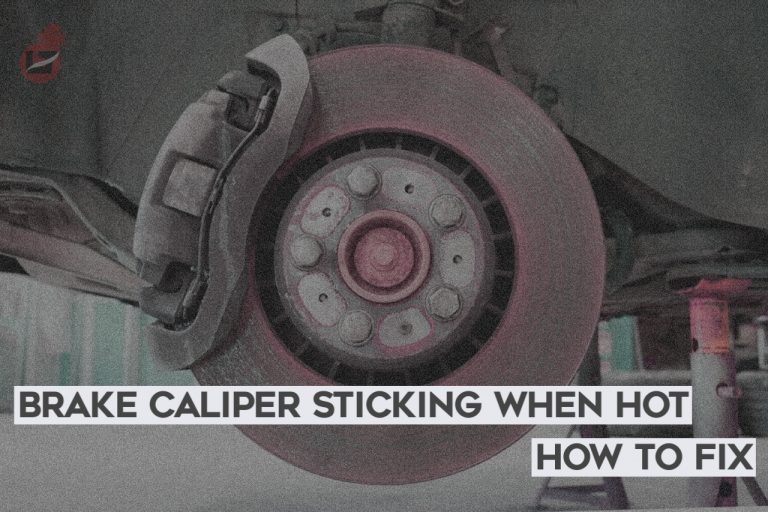A functional brake caliper is required for proper vehicle braking; what then happens if your brake caliper starts sticking when hot?
As we all know, the main differences between high-quality and inferior brakes are determined by how quickly the brake responds when applied.
A faulty brake caliper might affect the functionality of the brake system, thereby endangering the driver, passengers, and other road users.
Generally, a sticky brake caliper can be fixed by cleaning and repairing it or replacing it with a new one.
This article’ll discuss why brake calipers stick when hot, how it manifests, and how to restore their braking power.
How to Know if Your Brake Caliper is Sticking
Before concluding that your brake caliper is sticky when hot, it’s relevant to watch out for a few signs from your vehicle.
These obvious indications can be used to diagnose brake caliper sticking.
- One of the most evident signs of a stuck brake caliper is a vehicle pulling to one side. The car always pulls to the side with sticky brakes when one side of the brakes is stuck. This can be mistaken for a misaligned wheel.
- Another way to detect a sticking caliper is when your car slows down when in motion. This is primarily a result of the brake caliper being in contact with the rotors (aids in wear and tear of the brake pads and rotors).
- Also, your car’s fuel consumption rate will increase due to work imposed on the engine to keep the vehicle running at a pre-set speed.
- Finally, a sticky brake caliper will cause the wheels to produce excess heat due to the friction from the rotors and brake caliper, causing the motor to stop at intervals.
After the ride, be careful not to touch the wheels because they will be incredibly hot and could hurt your hands.
Brake Caliper Sticking When Hot – Causes
By default, Brake oil is forced through hoses into the brake caliper, which holds a brake pad, when you depress the brake pedal. As a result, when pressurized oil is injected into the brake caliper, the brake pad is forced onto the braking rotor by the caliper piston. The car stops because of the intense friction between the braking pad and the rotor.
But when your brake pad is always in contact with the brake rotor, even when you don’t intend to use the brakes, you have a sticky brake caliper.
Highlighted below are some factors that might cause your brake caliper to become sticky.
1. Worn-out Brake Hose
The brake hose that delivers oil to the brake calipers is worn out and dries up over time, developing cracks. This makes the caliper stick, causing brake oil to pour into the pistons. Failure to replace the brake hose could also result in a newly installed brake caliper sticking.
2. Stuck Brake Caliper Bolt
Bolts in the brake caliper are meant to move freely when the brake is applied and released with rubber guards keeping them away from rust and dust particles.
What occurs if these rubbers become worn out? The bolts become stuck due to rust and dust, which also causes the caliper to become sticky.
3. Dirt in Brake Caliper Slides
This is a reasonably typical reason why brake calipers stick. When the brake line is rusted, the caliper slides. When the brake pedal is depressed, the brake pad glides into slots on each caliper. When the brake pedal is released, the brake pad slips back into position in these grooves.
The presence of debris on the brake pad would result in restricted movement on the brake pads when you get your legs off the brake.
4. Wrong Brake Caliper Piston Installation
A rubber boot attached to the caliper piston’s end keeps it lubricated and shields it from dirt and dust. The dust boot may tear if a new brake pad is installed hastily or by an amateur mechanic. This keeps the caliper piston open, causing dust to cling to it. As a result, the brake and caliper piston won’t re-engage and instead adheres to the brake pad.
How to Fix a Sticky Brake Caliper
If you ever notice any of the symptoms mentioned above on your car, you are sure it has been identified as a sticky brake caliper.
Follow the below steps to fix it and restore your braking power.
- Firstly, raise your car using a floor jack and remove the wheel bolts to disassemble the tires – the front wheel.
- The brake caliper is inside the brake pad and over the braking rotor. To clean the brake assembly, use a brake cleaner spray.
- Use a socket nut and wrench to unbolt the brake caliper and pull them up while watching for the brake pipes.
- Now, remove the brake pads gently.
- You can now use a brake cleaner to clean the inside of the caliper to eliminate dust particles accumulated due to braking.
- Next, apply grease to the caliper side pins and bolts to enable free movement – white lithium grease is recommended.
- Also, inspect the brake caliper at the rear wheel and perform a clean-up if necessary.
- Finally, put the brake pad and caliper into the right place and tighten the bolts.
You can now proceed to test drive your car while watching out for any of the previous signs.
If the problem persists, you should seek a mechanic’s attention or perform a brake caliper replacement.
Final Words
A sticky brake caliper is a significant issue that must be addressed to avert accidents and also get the best driving experience.
You can apply the above fix to reinstate a sticky brake caliper; however, if the issue persists, you should take your car to an auto engineer for a replacement or inspection.
As an Amazon Service LLC Program Associate, V. Auto Basics earns from qualifying purchases. See Our Affiliate disclaimer.
